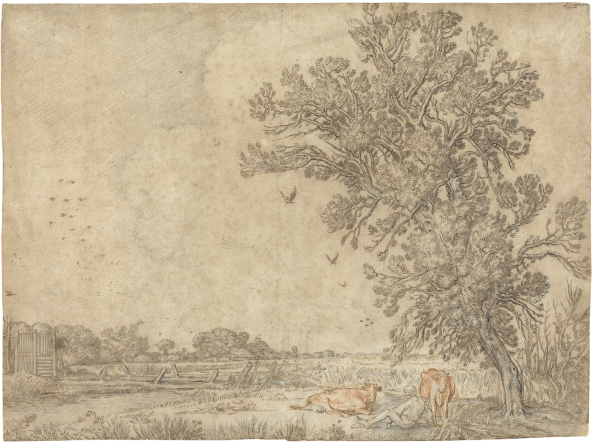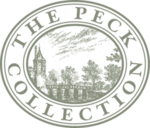Choose a background colour
Herman Saftleven, Dutch, 1609-1685: Cluster of Trees in the Dunes, c. 1627-30
Black chalk on paper; traces of brown ink framing lines.
10 3⁄16 × 14 13⁄16 in. (25.9 × 37.6 cm)
Recto, lower left, in black chalk by the artist, HSaft.leven (HS in ligature); upper right, in red chalk, remnants of an early inscription (possibly seventeenth century), v=[illegible]; verso, lower left, inscribed in pencil, No. 54 / Saftleven=093=1 / 746 Stug-; and center right, 9.815.
- Chain Lines:
- Vertical, 27 – 29 mm.
- Watermark:
- Bird in Circle (diameter 50 mm), probably Italian.
- Provenance:
Daan Cevat Gallery, London, 1963; Frans C. Butôt, 1906 – 1992, Sankt Gilgen (Austria); his sale, Sotheby’s, Amsterdam, 16 November 1993, lot 55; Sheldon and Leena Peck, Boston (Lugt 3847); gift to the Ackland Art Museum, inv. no. 2017.1.78.
- Literature/Exhibitions:
Bol, Keyes & Butôt 1981, 142 – 43, no. 54; Fechter 1989, 1768; Schulz (unpublished 2nd edition of Schulz 1982), planned as no. 338; F. Robinson in Chapel Hill, Ithaca & Worcester 1999 – 2001, 92 – 93, no. 29.
- Ackland Catalogue:
- 2017.1.78
This view, created when Herman Saftleven was about twenty years old, demonstrates the artist’s early engagement with the naturalistic dune landscapes depicted by contemporaries like Esaias van de Velde. Here, figures undertake various activities throughout the drawing, some visible along the fence leading to a village in the distance.
Saftleven used short, meticulously placed strokes of black charcoal for the ground elements and trees and closely placed parallel lines in the sky to indicate a partially cloudy day. An example of the artist’s mature style, which differs greatly in his use of black chalk, is displayed on the free-standing wall nearby.
Herman Saftleven was born and raised in Rotterdam, but established himself in Utrecht in the early 1630s, where he led a long and successful career as a landscape specialist and served several times as head of the artists’ guild. Besides his activities as a painter and etcher, he also left behind one of the largest bodies of drawings from the era, numbering around 1,400 works.1
Many of these are signed and finished sheets obviously intended for the flourishing collectors’ market.
While Saftleven’s mature drawing style is often immediately identifiable, a distinctively different approach can be found in the handful of surviving sheets from the earliest phase of his career, such as this one. At the time, the young artist was still in Rotterdam and under the spell of the drawings and prints of Willem Buytewech (1591/92 – 1624).2
Along with his contemporaries such as Jan van de Velde II (1593 – 1641), Esaias van de Velde (1587 – 1630), and Hercules Segers (1589/90 – after 1633), Buytewech explored new compositional formulas for depicting local Dutch landscape in innovative, yet convincingly naturalistic fashions.3
They eschewed the vast and imaginary mountainous constructions of previous generations in favor of charming evocations of their immediate surroundings, as well as the agricultural and festive activities of the local populace. Here Saftleven appropriated Buytewech’s use of short, precise strokes to render everything from ground features to trees, though he ultimately generated more featherlike patterns in his foliage than Buytewech, and employed a lighter touch overall. Saftleven set this scene in dunes just like those found outside of Haarlem, where Buytewech and the other landscape pioneers had been active. Some figures sit idly by while others work. A road probably stands behind the fence to the right, which leads to the village visible in the distance. The unusual thatched structure under the trees appears to be a temporary holding or storage pen of some sort.
Buytewech was himself originally from Rotterdam, but registered with the guild in Haarlem in 1612.44
He worked there until around 1617 before returning to his hometown, where his career ended prematurely with his death in 1624. There is no evidence that the two artists knew each other. Saftleven was only about fifteen years old when Buytewech died, too young to have studied with him beyond an early stage of apprenticeship. Saftleven’s father, however, was a professional artist and art dealer in Rotterdam (often assumed to be the teacher of his three artist sons), making the possibility of some degree of personal contact with Buytewech plausible.5
While Buytewech is now celebrated as one of the great innovators of Dutch landscape, his reputation in the years following his death is more difficult to determine, especially since his landscape drawings are quite rare today, and his landscape etchings only survive in a handful of impressions. Another artist who made landscape drawings in Buytewech’s style is Saftleven’s lesser-known contemporary, François Ryckhals (1609 – 1647), who may have also trained in Rotterdam, and has sometimes been cited as a possible influence on Saftleven’s early style.6
The Peck drawing is one of only about a half dozen drawings in Buytewech’s style that can be securely attributed to Saftleven.7
The attributions of some of these works have long proven problematic since only two of them are signed: one in Berlin with the artist’s monogram, and the present sheet, which is the only one that bears his full signature.8
Two unsigned sheets in London and Brussels are clearly preparatory for Saftleven’s series of five etchings in Buytewech’s style dated 1627, made when the artist was only about eighteen years old.9
Two further drawings in Brussels and Cambridge, both unsigned and unrelated to prints, have been convincingly linked to this early Saftleven group based on stylistic criteria.10
To these can be added a drawing in Darmstadt that is currently given to Jan van de Velde II, but more properly belongs to this early group of drawings by Herman Saftleven.11
This Peck sheet was unknown to Wolfgang Schulz when he published his definitive 1982 study of the artist, but he became aware of it sometime before the Butôt sale in 1993. He stated that he would include it in the second edition of his catalogue, which was slated for publication in 1994, but never materialized.12
Besides the fact that it is signed, a significant aspect of this drawing is its use of chalk. Previously catalogued works in this early Buytewech-style group are all somewhat smaller pen and ink drawings, from which it has been rightly assumed that Saftleven was influenced by Buytewech’s landscape etchings. A larger black chalk drawing like this one, however, suggests that Saftleven also had access to some of Buytewech’s remarkable black chalk landscape drawings, all of which are similar in size and format to the present work Fig. 12.1.13

Willem Buytewech, Meadow with a Shepherd and Cows, c. 1617. Black and red chalk, with pen and brush with brown ink, 281 × 379 mm. Washington, National Gallery of Art, inv. no. 1977.61.1.
National Gallery of Art, Washington. William Nelson Cromwell Fund
The particular form of signature in the Peck drawing, HSaft.leven, appears in a black chalk drawing of a barn interior dated 1630.14
We can assume that he executed the present drawing around the same time, or possibly slightly earlier in concordance with the Buytewech-style etchings from 1627. A slightly later date nevertheless remains appealing, since in this drawing Saftleven begins to show signs of departure from Buytewech’s style, searching instead for his own distinctive yet graceful, embroidery-like foliage effects.
End Notes
For Saftleven’s life and works, see Schulz 1982.
For Saftleven’s early works in Buytewech’s style, see Grosse 1925, 88 – 90; Haverkamp-Begemann 1959, 48 – 49; and Schulz 1982, 54 – 55, 227 – 30 (cat. nos. 330 – 37).
For developmental accounts of Dutch landscape and the roles of these Haarlem pioneers, see the classic studies of Stechow 1966 and Freedberg 1980, along with more recent contributions such as Leeflang 1997 and Gibson 2000. For a succinct account, see Peter Sutton in Amsterdam, Boston & Philadelphia 1987 – 88, 21 – 34.
See Haverkamp-Begemann 1959 for Buytewech’s life and works, still the essential study.
For Saftleven’s father, also named Herman, see Obreen 1877 – 90, vol. 5 (1882 – 83), 115 – 28, with a family tree. Obreen transcribed his death inventory from 1627, which only lists paintings, and none by Buytewech, but worth noting is the presence of paintings by other Haarlem pioneers such as Esaias van de Velde and Hercules Segers, the latter of which remained in the possession of his son Herman; see Leefl ang & Roelofs 2016, no. P6.
Haverkamp-Begemann 1959, 49; and Van Gelder 1967, 41.
Schulz 227 – 30, nos. 330, 333 – 37. Schulz only reluctantly accepted no. 337 (New Haven, Yale University Art Gallery, inv. no. 1967.68; see Haverkamp-Begemann & Logan 1970, no. 405), which indeed seems a different hand.
For the Berlin drawing (Schulz, no. 330), see also Grosse 1925, 72, pl. 70; and Bock & Rosenberg 1930, vol. 1, 266, no. 5365, vol. 2, pl. 191.
Schulz, nos. 334, 336. See also, for the Brussels drawing, Stefaan Hautekeete in Brussels, Amsterdam & Aachen 2007– 08, 91 – 93, no. 27; and for the London drawing, Hind 1915 – 32, vol. 4, 50, no. 1. For Saftleven’s 1627 series of etchings, see Hollstein, vol. 23, 131, nos. 20 – 24. His slightly larger etching, Field before Farm amid Trees (Hollstein, no. 38) also bears a striking resemblance to Buytewech’s style.
Schulz 1982, nos. 333, 335. For the Cambridge (Fitzwilliam) drawing, see also David Scrase in Munich, Heidelberg, Brunswick & Cambridge 1995 – 96, no. 24.
Darmstadt, Hessisches Landesmuseum, inv. no. ae 834; see Darmstadt 1992, 72 – 73, no. 24.
This according to the entry in the auction catalogue (Sotheby’s, Amsterdam, 16 November 1993, lot 55); as well as private correspondence between Sheldon Peck and Wolfgang Schulz (curatorial fi les, Ackland Art Museum).
For Buytewech’s black chalk drawings, see those in London, Courtauld Institute (see Haverkamp-Begemann 1959, no. 106); and Cambridge, Fitzwilliam Museum (idem, no. 107); and the two in Washington, National Gallery of Art (see Hofrichter 1983, nos. 22a, 22b).
Schulz 1982, no. 1406; and Robels 1983, 141, no. 239. Another black chalk drawing by Saftleven dated 1630 appeared on the art market after Schulz’s catalogue, present whereabouts unknown; see Sotheby’s, Amsterdam, 14 November 1988, no. 34; and Phillips, London, 11 December 1991, no. 140.
